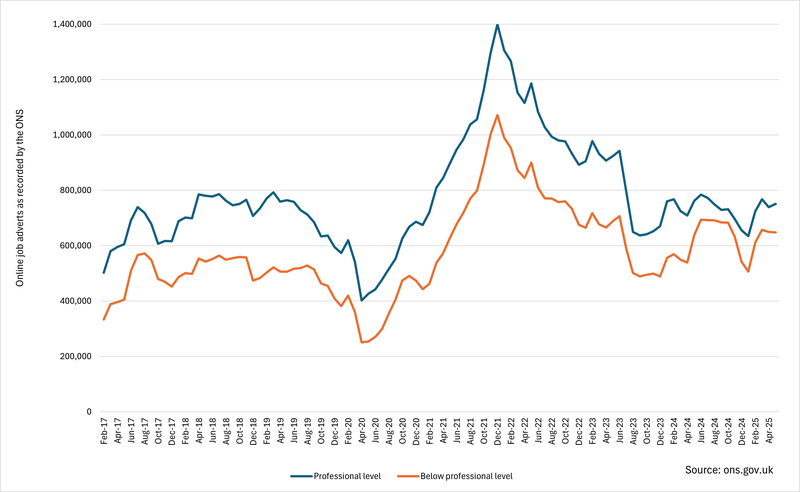Graduate Outcomes in context reveals a resilient graduate labour market

Newly released survey results paint a wider picture of the way the graduate labour market looks today.
The labour market context
The way the labour market has gone over the last few years is best summarised using this graph from the Office of National Statistics data on labour demand.
Online job adverts by occupational classification February 2017 to April 2025

There are a number of key features to bear in mind here. The first is that the majority of vacancies in the UK are at professional level and therefore mainly, or in many cases solely, available to graduates. Then we can see both the deep trough caused by COVID, and then the very large peak and subsequent elevated labour market that came about due to post-COVID occupational shortages. This meant that the graduate labour market in 2021 and 2022 was unusually strong and we should not expect jobs markets like those to be the norm in future.
Since 2022 the jobs market has been flat (the Recruitment and Employment Confederation (REC), the umbrella body for recruitment agencies, describe it as ‘stuck’). There’s a small trough at the end of 2024, around the time this graduate cohort were surveyed 15 months after they graduated in 2023. So we’d expect, all things being equal, to see the outcomes for this cohort’s graduates to be slightly, but not inordinately, worse than the last cohort’s.
And that’s exactly what we do see.
Today’s Graduate Outcomes data
88% of 2022/23 respondents were in work or study, down marginally from 89% last year and 90% the year before, but although a little disappointing, not a sign of a significant labour market downturn, and pretty much what you’d expect given other data available on labour market conditions.
59% of graduates were in full-time work, down from 61% last year but again not a steep fall. And the unemployment rate went up from 5% to 6%. As a (very) rough rule of thumb, anything under 5% represents a very strong graduate labour market, and anything from 7% up means we’re in a recession. We’re in the ‘fairly normal’ spectrum of unemployment rates although we do want to keep a close eye on that as much more movement upwards could be a signal for serious problems ahead.
So far, so expected. One thing you would expect is a slight rise in postgraduate study rates. This is generally counter-cyclical, in that it goes up as the graduate labour market dips. This doesn’t seem to have really happened this time around, possibly because graduates don’t themselves perceive the jobs market to have got notably worse.
Filling in the gaps
In order to try to understand the complex and shifting labour market in the UK, we need to stitch together a number of sources of data from across the country and from different sectors, all with their strengths and weaknesses. Official data sources are large but can lack detail. Vacancy surveys report quickly and give an increasingly good picture of the wider market, but can lack representativeness and so data on niche areas are not always ideally covered (we’ve seen that recently with some data on graduate recruitment being incomplete and so giving a falsely gloomy picture of the market). And specialist organisations can be very good in their own areas but obviously don’t give us a full picture.
What Graduate Outcomes data does is fill in all the gaps on the graduate labour market that other sources miss. This lets us both get the full picture but also to gauge where the strengths of those other sources lie and what we’re best to use them for. That’s incredibly valuable and means that not only can we go into tremendous detail about what graduates were doing at the end of 2024 but to cross reference that with more current data to give us a picture of where we are now.
This insight is only possible thanks to thousands of graduates who take the time to complete the Graduate Outcomes survey. Their input continues to be vital in helping the sector understand and respond to changing labour market conditions.
Getting help
The data is telling us that the market is, as REC are saying, a bit ‘stuck’. We’re not in the very difficult situation some sources have been saying, but nor is the current labour market as strong as it has been for graduates in the last few years since the pandemic.
There are jobs out there, graduates will still have options, but they will need support, guidance and good data to help them reach their potential. Head to Prospects Luminate for more analysis and guidance on helping graduates or check out our data analytics services for a really deep dive into Graduate Outcomes data.
There are also plenty of accredited official statistics available at HE Graduate Outcomes Data.
About the author

I am the in-house specialist on the graduate labour market. I research and analyse all things to do with post-18 employment, including regional economies, skills supply and demand and postgraduate issues, usually with a careers and employability perspective.